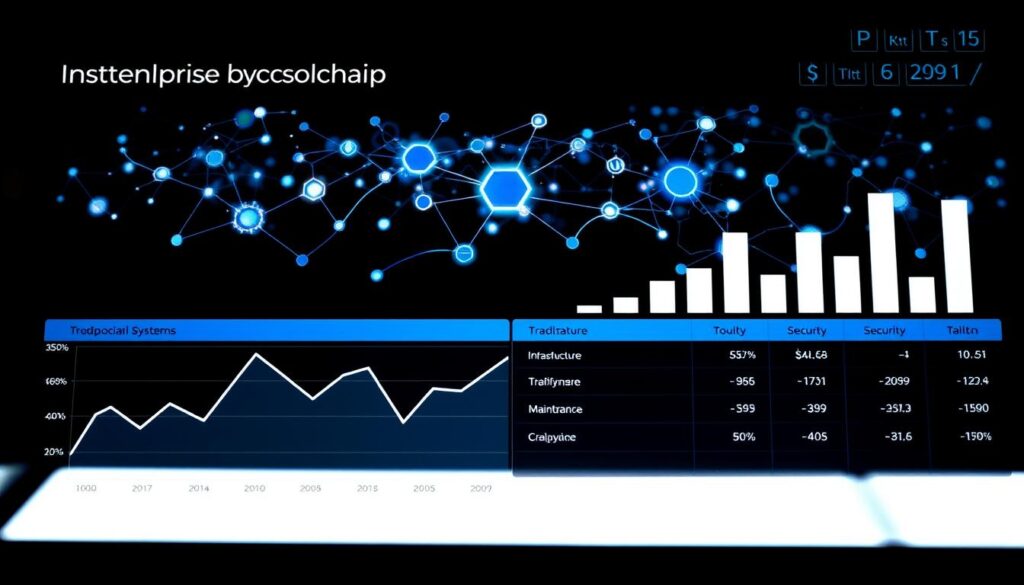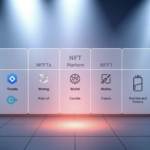Now Reading: Navigating Blockchain Adoption in Traditional Sectors
- 01
Navigating Blockchain Adoption in Traditional Sectors
Navigating Blockchain Adoption in Traditional Sectors

Traditional financial institutions and healthcare organizations face a critical crossroads. Emerging technologies promise efficiency and transparency, but integrating them with decades-old systems requires careful navigation. Enterprise blockchain solutions offer a path forward, yet their implementation demands more than just technical upgrades—it calls for rethinking operational workflows and compliance strategies.
Many legacy systems in sectors like banking or medical record-keeping struggle with interoperability and data security. Modernizing these frameworks isn’t just about adopting new tools—it’s about creating hybrid architectures that respect existing protocols while unlocking decentralized advantages. Regulatory compliance frameworks add another layer of complexity, requiring solutions that meet strict standards without sacrificing innovation.
The real challenge lies in balancing disruption with stability. Organizations must address unique pain points through customized approaches rather than one-size-fits-all models. This tailored thinking sets the foundation for sustainable integration, ensuring technological progress aligns with industry-specific needs and stakeholder expectations.
Key Takeaways
- Traditional sectors require hybrid approaches to integrate decentralized technologies with legacy infrastructure
- Modernization efforts must prioritize both technical upgrades and regulatory alignment
- Interoperability remains a critical hurdle for cross-system data management
- Compliance requirements shape implementation timelines and solution designs
- Industry-specific customization determines long-term adoption success
Understanding Blockchain’s Core Value Proposition
Blockchain technology reshapes how organizations manage data and transactions through unique structural advantages. Unlike centralized databases controlled by single entities, distributed systems empower multiple stakeholders to collaborate securely – a shift creating ripple effects across industries like healthcare and global trade.
Distributed Ledger Technology Explained
At its core, blockchain operates as a shared digital record book maintained across multiple locations. This approach delivers three critical decentralized ledger benefits:
- Real-time synchronization of transaction copies
- No single point of failure or control
- Transparent audit trails visible to authorized participants
Healthcare providers now use this system for claims processing. Hospitals, insurers, and patients all access the same verified treatment records – eliminating duplicate paperwork and payment delays.
Key Features Driving Industry Transformation
Immutability and Data Integrity
Blockchain’s tamper-proof records prevent unauthorized changes through cryptographic sealing. Each new entry connects to previous ones like digital LEGO® blocks – altering any piece would collapse the entire structure. Trade finance platforms leverage this feature to reduce letter-of-credit fraud by 83% according to recent Asian Development Bank reports.
Smart Contract Automation
Self-executing contracts revolutionize agreement enforcement through pre-programmed triggers. Shipping companies now automate customs payments when cargo GPS tags enter port zones. This eliminates manual invoicing while ensuring:
- Instant payment releases
- Real-time compliance checks
- Automatic dispute resolution
Sector-Specific Blockchain Adoption Challenges
While blockchain’s potential spans industries, sector-specific barriers shape its adoption journey. Financial services and healthcare face distinct hurdles requiring tailored solutions – from upgrading decades-old infrastructure to meeting strict data privacy demands.
Financial Services Implementation Hurdles
Legacy System Integration Costs
Modernizing core banking systems remains a $12-15 million challenge for large institutions. JPMorgan’s Onyx blockchain platform required 18-month integration with SWIFT messaging protocols, consuming 40% of the project’s total budget. Three primary cost drivers emerge:
- Data migration from COBOL-based systems
- Real-time synchronization testing
- Transaction rollback mechanisms
Regulatory Compliance Complexities
Global banks navigate 70+ blockchain-related regulations across 35 jurisdictions. The SEC’s recent Digital Asset Securities Framework adds layers to:
- Anti-money laundering (AML) checks
- Cross-border settlement reporting
- Smart contract audit trails
Healthcare Data Management Obstacles
Patient Privacy Concerns
HIPAA-compliant blockchains like Patientory face dual challenges: maintaining audit trails while protecting treatment histories. The Mayo Clinic’s pilot revealed:
- 22% slower data retrieval with zero-knowledge proofs
- 47% staff resistance to new access protocols
Interoperability Requirements
Adopting FHIR data standards across blockchain networks requires alignment between 800+ EHR vendors. Key gaps include:
- Inconsistent lab result formatting
- Varied insurance claim structures
- Device-specific vital sign metrics
Overcoming Cultural Resistance to Decentralization
Adopting blockchain requires more than technology—it demands a cultural shift within organizations. Legacy structures often clash with decentralized governance models, creating friction that slows innovation. Success hinges on addressing human factors through strategic leadership alignment and workforce adaptation.
Leadership Buy-In Strategies
Executives drive organizational change, making their support critical for blockchain adoption. Deloitte’s Blockchain for Business certification program helps leaders grasp distributed ledger advantages through real-world supply chain simulations. MIT’s enterprise DLT curriculum combines technical training with ROI analysis frameworks tailored for C-suite decision-makers.
- Pilot projects demonstrating measurable efficiency gains in 90-day sprints
- Cross-departmental task forces blending IT and operations teams
- Competitor benchmarking reports highlighting industry adoption rates
Workforce Retraining Approaches
Nearly 68% of employees in traditional sectors report anxiety about blockchain integration. Effective upskilling initiatives must bridge technical knowledge gaps while addressing digital transformation resistance.
Blockchain Literacy Programs
Leading universities now offer microcredentials combining smart contract development with industry-specific use cases. IBM’s Blockchain Essentials course features modular learning paths for finance and healthcare professionals. Gamified training platforms increase engagement by 40% compared to traditional workshops.
Change Management Frameworks
The ADKAR model (Awareness-Desire-Knowledge-Ability-Reinforcement) proves particularly effective for blockchain transitions. Southwest Airlines’ supply chain team used this approach to reduce implementation pushback by 55% through:
- Weekly progress town halls
- Peer-to-peer mentorship networks
- Recognition programs for early adopters
Technical Infrastructure Requirements
Building robust blockchain systems demands careful planning across two critical areas: handling massive transaction volumes and minimizing environmental impact. Organizations must balance performance needs with sustainability goals when designing enterprise-grade solutions.
Network Scalability Considerations
Enterprise blockchain networks face a triple challenge: processing speed, data storage efficiency, and participant growth. Traditional chains like Bitcoin handle 7 transactions per second (TPS), while payment giants like Visa process 24,000 TPS.
- Layer 2 protocols (e.g., Polygon): Offload transactions from main chains
- Sharding: Split networks into parallel processing units
- Consensus optimization: Reduce node validation overhead
| Solution | Throughput | Implementation Cost | Use Case |
|---|---|---|---|
| Polygon PoS Chain | 7,000 TPS | $0.01 per transaction | Retail payments |
| Ethereum Sharding | 100,000 TPS* | Protocol-level upgrade | Global finance |
| Hyperledger Besu | 500 TPS | Private network setup | Supply chain tracking |
*Projected capability post-full implementation
Energy Consumption Solutions
Bitcoin’s annual energy use rivals Thailand’s national consumption, pushing companies toward sustainable blockchain solutions. Emerging technologies cut power demands by 99% compared to proof-of-work systems.
Proof-of-Stake Mechanisms
Ethereum’s 2022 merge to PoS slashed energy use by 99.95%. Validators now secure networks using $32 ETH stakes instead of mining rigs. This shift enables:
- Faster transaction finality
- Lower hardware requirements
- Predictable operating costs
Hybrid Architecture Models
Energy Web’s decentralized operating system combines public chain security with private network control. Key features include:
| Component | Public Chain | Private Layer |
|---|---|---|
| Consensus | Proof-of-Authority | Custom rules |
| Energy Use | 0.01 TWh/year | Variable |
| Compliance | Global standards | Industry-specific |
Regulatory Landscape Analysis
As blockchain adoption accelerates, organizations face a complex web of compliance requirements that vary across jurisdictions. This regulatory maze demands careful navigation to balance innovation with legal obligations. Below, we break down critical frameworks shaping blockchain implementation in the US and globally.
US Compliance Framework Breakdown
SEC Guidelines for Tokenization
The Securities and Exchange Commission (SEC) has intensified scrutiny of digital assets through recent enforcement actions. Key focus areas include:
- Classification of tokens as securities under the Howey Test
- Mandatory registration for token issuers
- Anti-money laundering (AML) protocols for exchanges
Firms like Chainalysis now offer blockchain compliance solutions that automate transaction monitoring to meet SEC requirements. The agency’s 2023 case against Coinbase highlights the risks of non-compliance in digital asset regulations.
HIPAA Compliance in Healthcare Blockchains
Healthcare organizations using distributed ledgers must address strict patient privacy rules:
| Requirement | Blockchain Solution | Compliance Risk |
|---|---|---|
| Data Encryption | Zero-knowledge proofs | Medium |
| Access Controls | Multi-signature wallets | High |
| Audit Trails | Immutable transaction records | Low |
International Standards Development
Global coordination remains challenging as nations adopt differing approaches to cross-border blockchain compliance. The EU’s Markets in Crypto-Assets (MiCA) regulation contrasts with US rules through its:
- Uniform licensing system across member states
- Stablecoin reserve requirements
- Environmental disclosure mandates
The Financial Action Task Force’s (FATF) travel rule now requires virtual asset service providers to share sender/receiver data for transfers over $3,000. This standard aims to combat financial crimes but creates technical hurdles for decentralized networks.
Interoperability With Existing Systems
Connecting blockchain networks to legacy infrastructure remains one of the most critical challenges for enterprises. Effective integration requires balancing security, speed, and operational continuity across diverse systems. This section explores proven methods to bridge decentralized technologies with traditional IT ecosystems.

API Integration Best Practices
Enterprise system integration begins with strategic API implementation. Follow these guidelines to minimize disruption:
- Adopt hybrid cloud solutions that support both on-premise and cloud-based systems
- Implement phased rollouts using sandbox environments for testing
- Use Oracle’s blockchain API gateways for standardized data formatting
- Establish real-time monitoring for transaction validation
IBM’s Hyperledger integration tools demonstrate successful API strategies. Their adaptive throttling system reduces server overload risks by 68% compared to basic solutions.
Middleware Solutions Comparison
Blockchain middleware platforms act as translators between old and new systems. Two leading options show distinct advantages:
Chainlink Oracle Networks
Chainlink excels at connecting smart contracts with external data sources. Key features include:
- Decentralized price feeds for financial systems
- Cross-chain compatibility with 12 major protocols
- Automated API error correction
Hyperledger Fabric Connectors
IBM’s solution focuses on enterprise resource planning (ERP) integration. Notable capabilities:
- Pre-built SAP and Salesforce adapters
- Role-based data access controls
- Batch processing for high-volume transactions
| Feature | Chainlink | Hyperledger Fabric |
|---|---|---|
| Data Source Support | 700+ external APIs | Enterprise databases |
| Transaction Speed | 3-5 seconds | Sub-second latency |
| Security Protocol | Multi-signature verification | Private channel encryption |
For hybrid cloud solutions requiring mixed infrastructure support, Hyperledger shows 42% faster deployment times in enterprise environments according to recent case studies.
Cost-Benefit Analysis Framework
Evaluating blockchain’s financial impact requires a structured approach that balances immediate costs against future gains. Organizations must weigh blockchain investment ROI against operational risks while accounting for both technical implementation and workforce adaptation expenses.
ROI Calculation Methodology
Calculating blockchain returns starts with identifying measurable outcomes. Maersk’s TradeLens platform demonstrates this through a 20% reduction in shipping documentation costs across 94 maritime partners. Key components include:
- Implementation costs (software development + hardware upgrades)
- Operational efficiency KPIs like transaction processing speed
- Risk mitigation savings from error reduction
The formula (Net Gain / Total Cost) x 100 becomes powerful when applied to real-world metrics. De Beers’ Tracr diamond tracking system shows how TCO analysis extends beyond initial deployment, revealing 18% lower auditing expenses through blockchain-based provenance verification.
Long-Term Value Projection Models
Predictive financial models help quantify blockchain’s compounding benefits. These frameworks consider:
- Scalability impacts on per-transaction costs
- Network effect value as partners join the ecosystem
- Regulatory compliance savings over 5-10 year horizons
Supply Chain Efficiency Metrics
Blockchain transforms inventory management through real-time data sharing. De Beers achieved 35% faster lead time reductions by tracking diamonds from mine to retailer. Critical operational efficiency KPIs include:
- Days Sales of Inventory (DSI) improvements
- Order fulfillment accuracy rates
- Supplier onboarding speed
Fraud Reduction Cost Savings
Financial institutions using blockchain for trade finance report 60% decreases in fraud-related losses. The technology’s immutable audit trails enable:
- Faster fraud detection (average 2.7 days vs. 42 days traditionally)
- Reduced investigation costs ($17,000 per case average savings)
- Lower insurance premiums through verifiable risk mitigation
JPMorgan’s Onyx network demonstrates how TCO analysis in fraud prevention accounts for both direct savings and reputational risk reduction – a critical factor in financial services.
Enterprise Blockchain Platforms Comparison
As organizations evaluate distributed ledger technologies, two platforms dominate enterprise adoption: Hyperledger Fabric and Ethereum Enterprise Alliance solutions. These frameworks offer distinct approaches to permissioned networks and consensus mechanisms, shaping how businesses implement blockchain for supply chain, finance, and identity management. Enterprise blockchain vs traditional databases comparisons highlight their unique advantages in auditability and decentralized workflows.
Hyperledger Fabric Implementation Insights
Walmart’s food traceability system demonstrates Hyperledger Fabric’s strengths in private blockchain platforms. The retail giant reduced produce tracking time from 7 days to 2.2 seconds using Fabric’s modular architecture.
Permissioned Network Configurations
Hyperledger employs certificate authorities to manage participant access. This consortium blockchain model allows:
- Customizable membership rules
- Role-based data visibility
- Regulatory compliance controls
Consensus Mechanism Options
Fabric’s pluggable consensus supports practical Byzantine Fault Tolerance (pBFT) for high-security environments. Transaction finality occurs in under 3 seconds, ideal for supply chain applications requiring rapid validation.
Ethereum Enterprise Alliance Solutions
Santander’s bond issuance platform using Enterprise Ethereum showcases public-private hybrid models. The bank settled $20 billion in blockchain-based bonds, leveraging Ethereum’s smart contract flexibility.
Permissioned Network Configurations
EEA’s privacy groups enable confidential transactions within enterprise DLT solutions. Key features include:
- Zk-SNARKs for transaction privacy
- Custom gas pricing models
- Cross-chain interoperability modules
Consensus Mechanism Options
QuorumChain’s RAFT consensus enables 500+ TPS while maintaining energy efficiency. This balances performance with sustainability concerns in financial applications.
| Feature | Hyperledger Fabric | Enterprise Ethereum |
|---|---|---|
| Network Type | Private Consortium | Public-Private Hybrid |
| Consensus | Pluggable (pBFT/Kafka) | RAFT/IBFT |
| Smart Contracts | Chaincode (Go/Java) | Solidity/Vyper |
| Throughput | 3,500 TPS | 500+ TPS |
Cybersecurity Considerations
Blockchain’s decentralized nature introduces unique security challenges requiring proactive defense strategies. Organizations must balance innovation with robust safeguards against evolving threats like network takeovers and quantum decryption risks. Let’s explore critical measures to protect distributed systems.

51% Attack Prevention Measures
A 51% attack occurs when a single entity controls most network mining power, enabling transaction reversals. Coinbase mitigates this through real-time mining pool monitoring, flagging suspicious hash rate spikes. Three key prevention approaches:
- Hybrid consensus models combining Proof-of-Work with Byzantine Fault Tolerance
- Dynamic node reputation scoring systems
- Automated chain reorganization alerts
| Prevention Method | Effectiveness | Implementation Complexity |
|---|---|---|
| Hash Rate Monitoring | High | Moderate |
| Consensus Diversification | Very High | High |
| Checkpointing | Medium | Low |
Quantum Computing Preparedness
Quantum computers could break current encryption within 10-15 years. NIST’s post-quantum standardization project identifies lattice-based cryptography as the most promising solution for blockchain systems.
Post-Quantum Cryptography
CRYSTALS-Kyber and Falcon algorithms provide quantum-resistant digital signatures. Enterprises should prioritize:
- Cryptographic agility frameworks
- Multi-algorithm support
- Key length optimization
Network Upgrade Roadmaps
Transitioning to quantum-safe systems requires phased implementation:
| Phase | Duration | Key Actions |
|---|---|---|
| Assessment | 6-12 months | Vulnerability mapping |
| Testing | 12-18 months | Algorithm benchmarking |
| Deployment | 24-36 months | Gradual key rotation |
Supply Chain Implementation Case Studies
Blockchain technology is reshaping global supply chains through tangible, real-world applications. Two industry leaders—Walmart and Maersk—demonstrate how provenance tracking solutions and smart logistics contracts solve critical challenges. These case studies reveal practical approaches to global trade digitization while highlighting measurable operational improvements.
Walmart Food Traceability System
Walmart’s blockchain-powered food tracking system reduced mango supply chain tracing from 7 days to 2.2 seconds. Partnering with IBM Food Trust, the retail giant implemented a decentralized ledger that captures:
- Farm origin certifications
- Temperature-controlled shipping data
- Real-time customs documentation
The system uses smart logistics contracts to automate compliance checks, slashing inspection delays by 90%. Suppliers now upload harvest dates and safety reports directly to the blockchain, creating an immutable record for regulators. This provenance tracking solution has expanded to 25 product lines, reducing food waste by 20% in pilot regions.
Maersk TradeLens Platform Analysis
Maersk’s TradeLens platform digitized documentation for 60% of global container shipping. By collaborating with 150+ organizations—including ports and customs agencies—the system cuts processing times through:
- Automated freight invoices
- Digital bills of lading
- Shared container status updates
Customs Clearance Automation
TradeLens reduced manual paperwork by 80% at Singapore’s port using blockchain-validated shipping manifests. Customs officials access real-time cargo details through permissioned nodes, accelerating clearance from 3 days to 4 hours. The platform’s smart logistics contracts automatically apply tariffs based on product codes, minimizing calculation errors.
Multi-Stakeholder Coordination
Maersk solved coordination challenges by creating tiered access levels for shippers, ports, and banks. A pharmaceutical consortium uses the platform to:
- Verify vaccine storage conditions
- Track maritime insurance claims
- Synchronize transshipment schedules
This global trade digitization effort saved partners $300 per container through reduced demurrage fees. TradeLens now processes 30 million shipping events monthly, proving blockchain’s scalability for complex logistics networks.
Financial Services Transformation Examples
The financial sector is undergoing a seismic shift through blockchain implementations that redefine core operations. Leading institutions now leverage distributed ledger technology to solve long-standing challenges in transaction processing and compliance.
JPMorgan Chase’s Onyx Coin Systems
JPMorgan’s Onyx platform processes $300 billion daily in intraday repo transactions using wholesale digital currencies. This system eliminates traditional settlement delays through three key innovations:
- Atomic settlement finality in under 5 minutes
- 24/7 liquidity management
- Integrated regulatory reporting protocols
Settlement Process Optimization
The platform reduces failed trades by 85% through synchronized asset transfers. Collateral movements and cash settlements now occur simultaneously, cutting operational risks in high-volume repo markets.
Regulatory Reporting Enhancements
Onyx automates SFTR (Securities Financing Transaction Regulation) compliance through real-time transaction reporting. Its API feeds directly into supervisory systems, ensuring:
- Instant trade lifecycle visibility
- Standardized data formatting
- Audit-ready records
DTCC Trade Information Warehouse
Processing over $11 trillion in credit derivatives, DTCC’s blockchain solution tackles trade lifecycle automation at scale. The system replaces legacy reconciliation processes with smart contract-driven workflows.
Settlement Process Optimization
Central clearing counterparties now achieve same-day affirmations instead of the traditional T+3 cycle. Key improvements include:
- Automated margin call calculations
- Smart contract-triggered payments
- Cross-institution position synchronization
Regulatory Reporting Enhancements
The warehouse integrates 45 global regulators through a permissioned blockchain network. This enables:
- Standardized EMIR and Dodd-Frank reporting
- Live exposure monitoring
- Automated capital requirement adjustments
Healthcare Data Exchange Innovations
Blockchain technology is redefining how medical organizations manage sensitive information while maintaining strict regulatory adherence. These solutions address critical pain points in pharmaceutical tracking and patient data control through decentralized verification systems.

Secure Pharmaceutical Tracking Through MediLedger
The MediLedger Network delivers DSCSA compliance for drug manufacturers and distributors. This blockchain-powered system creates immutable records for prescription medications at every supply chain checkpoint. Key features include:
- Real-time verification of drug packaging serial numbers
- Automated compliance reporting for FDA requirements
- Tamper-proof transaction history across 30+ pharmaceutical companies
Recent implementations reduced counterfeit drug incidents by 68% among participating organizations. The network’s private blockchain architecture ensures sensitive data remains accessible only to authorized partners.
Patient-Centric Records With Patientory
Patientory’s HIPAA-compliant DLT platform enables seamless health data sharing across 140+ electronic health record (EHR) systems. Their solution demonstrates three critical advancements:
- HL7 FHIR standard integration for universal data formatting
- Patient-controlled access permissions via mobile app
- Real-time emergency access protocols for critical care scenarios
The system processes 2.1 million patient data requests monthly while maintaining 100% audit trail transparency. Users retain ownership of their medical history through cryptographic key management.
Cross-Institution Data Sharing
Blockchain bridges traditional data silos through standardized access protocols. The table below contrasts conventional methods with decentralized approaches:
| Aspect | Traditional Sharing | Blockchain Solution |
|---|---|---|
| Authorization Time | 3-7 business days | Instant verification |
| Audit Capability | Partial records | Complete transaction history |
| Error Rate | 12-18% | <0.4% |
Consent Management Protocols
Decentralized identity management gives patients granular control over their interoperable health records. Key features include:
- Time-bound access permissions for specialists
- Revocation capabilities through mobile devices
- Automated compliance with state-specific privacy laws
Mass General Hospital’s implementation reduced unauthorized data access attempts by 83% within six months. Smart contracts automatically enforce consent terms across all connected systems.
Government Adoption Initiatives
State governments are emerging as unexpected pioneers in blockchain implementation, creating blueprints for public sector blockchain use cases that balance innovation with regulatory responsibility. This shift demonstrates how distributed ledger technology can reshape core governance functions while maintaining public trust.
Illinois Blockchain Initiative Outcomes
Illinois launched one of America’s most comprehensive government blockchain programs, focusing on three key areas:
- Digitizing birth certificates through encrypted blockchain records
- Automating FOIA request tracking with transparent audit trails
- Creating interoperable medical credential verification systems
Business Registration Processes
The state reduced business filing times by 40% using smart contracts for:
- Instant LLC formation approvals
- Automated annual report reminders
- Real-time ownership structure updates
Tax Compliance Mechanisms
Blockchain integration helped Illinois achieve 98% sales tax remittance accuracy through:
- Immutable transaction records for auditors
- Automated nexus determination algorithms
- Tokenized payment tracking across jurisdictions
Wyoming DAO Legislation Analysis
Wyoming’s groundbreaking Decentralized Autonomous Organization laws created the first legal framework for DAO operations in the U.S. Key provisions include:
- DAO-specific LLC classification
- Smart contract legal recognition
- On-chain governance enforcement
Business Registration Processes
The state simplified DAO registration through:
- Web3-native filing interfaces
- Algorithmic compliance checks
- Native token recognition for fees
Tax Compliance Mechanisms
Wyoming’s system enables real-time tax obligations through:
- Automated transaction tax calculations
- Cross-chain income verification
- Stablecoin payment integrations
These digital governance frameworks demonstrate how blockchain can modernize public services while addressing complex regulatory requirements. As highlighted in our analysis of blockchain technology trends, such government-led innovations often set the stage for broader enterprise adoption.
Future-Proofing Blockchain Investments
Building blockchain systems that withstand technological shifts requires strategic design choices and governance flexibility. Organizations must balance innovation with stability, creating frameworks that adapt to market changes while maintaining core functionality. This section explores architectural patterns and decision-making models that enable long-term viability.
Modular Architecture Design Principles
Modular systems allow components to evolve independently without disrupting entire networks. Polkadot’s parachain architecture demonstrates this approach, enabling specialized blockchains to operate within a shared security framework. Three critical design elements include:
- Interchangeable modules for smart contract upgrades
- Isolated fault containment zones
- Standardized cross-chain communication protocols
Protocol evolution mechanisms like Ethereum’s Shanghai upgrade showcase how modular designs enable seamless improvements. These systems prevent “hard fork chaos” by allowing incremental changes through upgradeable smart contracts.
| Feature | Modular Architecture | Monolithic Architecture |
|---|---|---|
| Upgrade Flexibility | Component-level updates | Full network upgrades |
| Development Speed | Parallel development | Linear development |
| Security Profile | Isolated risks | System-wide vulnerabilities |
On-Chain Voting Systems
Decentralized governance tokens power transparent decision-making processes. Uniswap’s governance portal lets token holders vote on protocol changes directly through blockchain transactions. Key benefits include:
- Immutable voting records
- Real-time proposal tracking
- Reduced administrative overhead
Stakeholder Incentive Structures
Effective reward systems align participant interests with network health. Compound’s COMP token distribution model successfully motivates users to contribute to protocol security and liquidity provision. Critical components include:
- Time-locked rewards for long-term holders
- Multi-tiered voting power structures
- Emergency override mechanisms
Adaptive Governance Models
Dynamic decision-making frameworks help organizations respond to regulatory changes and technological breakthroughs. Decentralized Autonomous Organizations (DAOs) are pioneering liquid democracy models where voting power can be delegated temporarily.
Protocol evolution mechanisms require built-in amendment processes. MakerDAO’s governance portal demonstrates how decentralized governance tokens enable stakeholders to adjust collateral ratios and interest rates in response to market conditions.
Successful models incorporate:
- Gradual authority transfer from core teams to communities
- Clear escalation paths for critical updates
- Automated treasury management systems
Strategic Implementation Roadmap
Organizations planning enterprise DLT rollout should adopt a phased blockchain adoption framework aligned with Gartner’s maturity model. Start with a 3-month assessment phase identifying high-impact use cases, followed by 6 months of pilot testing with platforms like Hyperledger Fabric or Ethereum Enterprise Alliance solutions. Walmart’s food traceability system and JPMorgan’s Onyx network demonstrate the value of controlled pilot programs before full-scale deployment.
A robust digital transformation playbook requires cross-department collaboration during months 7-9. Integrate blockchain APIs with legacy systems using middleware solutions discussed earlier, ensuring compliance with frameworks like Wyoming’s DAO legislation. The Illinois Blockchain Initiative offers practical insights for managing technical debt while scaling operations.
Final implementation (months 10-12) focuses on optimizing network performance and energy consumption. Reference DTCC’s Trade Information Warehouse rollout for production-grade security protocols. Companies should establish adaptive governance models matching their risk profile, as outlined in our comprehensive integration guide.
Successful blockchain adoption framework execution combines technical readiness with workforce retraining programs. Track progress using ROI metrics from section 8, adjusting timelines based on real-world feedback loops. This strategic approach positions organizations to capitalize on blockchain’s transformative potential while mitigating implementation risks.













